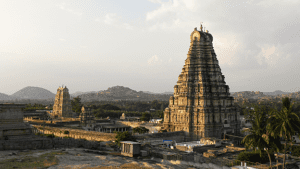TAG: GS 1: ART AND CULTURE
THE CONTEXT: A portion of the Virupaksha temple in Hampi, Karnataka, recently collapsed following heavy rains on May 21, 2024.
EXPLANATION:
- The temple, a nationally protected monument and a UNESCO World Heritage Site, has a rich history and faces several contemporary threats.
Virupaksha Temple
- While legends trace the temple’s origins back to earlier times, the Virupaksha temple prominently gained attention and underwent substantial expansion in the 14th century during the Vijayanagara Empire (1336-1646).
- Founded by Harihara I of the Sangama dynasty, the Vijayanagara Empire’s rulers were great builders and patrons of art.
- Under their reign, the temple became a central hub for religious and cultural activities.
- The temple is a prime example of Dravidian temple architecture, characterized by its grand gopurams (towering gateways), the towering shikhara over the sanctum sanctorum, intricate carvings, and pillared halls.
- The richly adorned gopuram features carvings of various deities, mythological scenes, and animals.
- The sanctum sanctorum houses the Shiva lingam, the primary object of worship.
- As part of Hampi, the capital city of the Vijayanagara Empire, the temple stands as evidence of the last ‘great Hindu empire’ of South India.
- UNESCO recognized its uniqueness by categorizing the Group of Monuments at Hampi as a World Heritage Site.

An earlier view of the Virupaksha Temple in Hampi, Karnataka.
Causes of the Collapse
- The pavilion or saalu mantap of the Virupaksha temple collapsed due to heavy rains.
- ASI officials indicated that the stone pillars, which had deteriorated over time due to natural phenomena like rain, led to the collapse.
- The ASI was aware of the weak foundation of the pavilion.
- Superintendent Archaeologist of the ASI’s Hampi Circle mentioned that although restoration was planned, the pillars’ condition was worse than estimated, causing an early collapse.
Restoration Efforts by ASI
- Before initiating restoration work, the ASI digitally documented all the monuments under its control in Hampi.
- Restoration efforts began in 2019, with the first phase completed between 2019-2020 and the second phase between 2021-2022.
- The pavilion was scheduled for later restoration.
Response to Collapse
- Following the collapse, the ASI dismantled the entire pavilion for restoration on a priority basis.
- A committee comprising senior archaeologists, conservationists, and engineers was formed to review and document the damage and restoration requirements.
- Restoration is estimated to cost approximately Rs 50 lakhs and is expected to take three to four months.
- Funding and logistics, alongside human resource constraints, pose significant challenges.
Broader Challenges and Concerns
- Restoration efforts are hampered by financial constraints.
- The Central government granted Rs 8 crore for restoring monuments in the Kalyan Karnataka region, but resources are still limited.
- Restoring stone pillars necessitates using the same type of stone originally used, which involves traditional, time-consuming methods.
- The Virupaksha temple remains in constant worship, leading to continuous additions and alterations that affect its original structure.
- Modern shops, restaurants, and infrastructural developments around the temple complex have adversely impacted its historical setting.
- The UNESCO website highlights the tension between modern usage and preserving the ancient fabric.

